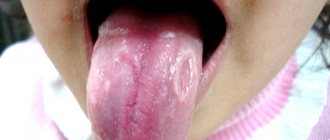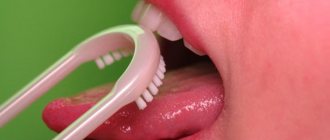Types of stomatitis
Depending on the nature of the disease and its clinical manifestations, experts divide catarrhal, catarrhal-hemorrhagic, as well as bullous, erosive, ulcerative-necrotic and allergic stomatitis.
The latter, in turn, is divided into the following types:
- medicinal;
- contact, for example, as an allergy to dentures, braces, plates;
- catarrhal;
- catarrhal-hemorrhagic;
- ulcerative-necrotic;
- erosive.
From the point of view of etiology and pathogenesis, allergic stomatitis includes medication, contact (including dentures), toxic-allergic, autoimmune dermatostomatitis, chronic recurrent aphthous stomatitis and other forms.
Depending on the speed of development of the reaction, doctors distinguish immediate and delayed types of allergic stomatitis. In the first case, angioedema is observed, and in the delayed type, the reaction to a particular irritant usually appears a few days after contact with the allergen.
In rare cases, allergic stomatitis develops while wearing dentures. Sometimes a reaction occurs even after 5–10 years of wearing them, after a long asymptomatic period.
Ask a Question
Causes of development of allergic stomatitis
The main cause of pathology is the entry of an allergen into the body. Allergies can occur due to taking antibiotics, insect bites, accumulation of dust, food or contact with materials. Depending on the cause, there are several types of allergic stomatitis.
Contact allergic stomatitis
Occurs due to the effect of drugs and materials on the mucous membrane, for example, orthodontic apparatus, prosthesis or cement for its installation. The formations are usually located only at the site of contact of the mucous membrane with the irritant. A distinctive sign is swelling of the cervical lymph nodes.
Toxic-allergic stomatitis
Appears when pathogenic organisms multiply in the oral cavity, causing toxic poisoning. It is characterized by swelling of the mucous membrane, milky or brownish coating on the tongue.
Drug-induced allergic stomatitis
Develops after taking medications orally or when applied topically. Accompanied by nausea, headache, difficulty breathing, fever and numerous rashes. With drug-induced stomatitis, it is necessary to first relieve the symptoms of intoxication and only then treat the external manifestations of the pathology.
Causes of the disease
As is clear from the name of the disease, a negative reaction of the body develops after contact with various allergens. Most often, allergic stomatitis occurs after contact with plant pollen or mold spores. The disease can also manifest itself against the background of:
- installation of crowns, fillings, prostheses made of low-quality materials;
- consumption of certain types of food (especially in children);
- decreased immunity;
- course of treatment with antibacterial drugs or sulfonamides;
- advanced caries;
- bleeding gums;
- inflammation of the oral cavity;
- proliferation of pathogenic microorganisms in the oral cavity.
Sometimes allergic stomatitis manifests itself as a complication of Lyme disease, systemic lupus erythematosus, aphthous stomatitis, hemorrhagic diathesis, and Stevens-Johnson syndrome.
Symptoms
The disease is characterized by general and local symptoms. The first symptoms of a mild form of allergic stomatitis are:
- slight discomfort in the oral cavity during hygiene procedures and eating;
- inflammation and swelling of tissues;
- redness and itching of the affected areas of the mucous membrane;
- excessive salivation.
If allergic stomatitis began while taking certain medications, the patient complains of painful blisters filled with liquid. Tick-borne borreliosis is accompanied by redness, blisters on the mucous membranes, as well as bleeding erosions and wounds.
Allergic stomatitis without proper treatment develops very quickly: the patient’s body temperature rises, and bubbles and blisters appear on the skin, mucous membranes of the eyes, and genitals.
If the disease was caused by Lyme disease, red spots with a border appear in different parts of the body and are very painful. Sometimes patients complain of joint pain.
Erosive-ulcerative stomatitis, cheilitis, glossitis
This disease is manifested by hyperemia and swelling of the palate, gums, lips, tongue and cheeks, the appearance of blisters with transparent contents, after opening of which erosions are formed, covered with fibrinous plaque. These symptoms are accompanied by pain, which is aggravated by eating and talking. Weakness, loss of appetite, and increased body temperature up to 38C may appear.
The disease is easily confused with acute herpetic stomatitis, erythema multiforme and pemphigus, so the diagnosis is carried out by an allergist together with a dermatologist.
Treatment consists of discontinuing the intolerable drug and prescribing antihistamines. In severe cases, corticosteroids are prescribed. Local treatment includes painkillers and antiseptic treatment of the oral cavity. It is recommended to eat non-irritating foods and drink plenty of fluids.
Diagnostics
The diagnosis of “allergic stomatitis” is made by a dentist based on an examination of the oral cavity and questioning the patient about underlying diseases and medication use. The dentist clarifies the clinical picture of the disease.
The doctor must conduct a comprehensive examination and diagnosis:
- removable and fixed prostheses;
- braces;
- filling
To clarify the clinical picture of the disease, the specialist refers the patient for a comprehensive blood and urine test and an immunogram to assess the state of the immune system. If necessary, the doctor sends the patient for the following studies:
- determination of the acidity level and composition of saliva;
- identification of the activity of enzymes contained in saliva;
- leukopenic test;
- provocative tests with removal and subsequent installation of prostheses.
An integrated approach to diagnosing allergic stomatitis will allow you to quickly find out the cause of the negative reaction, eliminate it and begin effective treatment.
Treatment of allergic stomatitis in adults
If the dentist confirms the diagnosis, he first prescribes complex therapy. It is important not only to eliminate the painful external manifestations of the disease, but also to adjust drug treatment, change the patient’s lifestyle and, if necessary, discontinue medications that caused irritation.
Folk remedies are excellent aids in treating the disease, but using herbal infusions alone will not completely get rid of the disease. The main thing is to determine the cause of the allergy and eliminate it as soon as possible.
The main directions in the treatment of stomatitis are:
- identification and elimination of allergens;
- selection of suitable orthopedic structures (if an allergy to them is identified);
- replacement of low-quality fillings;
- selection of softer and more gentle medications;
- taking antihistamines and antiallergic drugs;
- use of local antiseptics and painkillers;
- disinfection of mucous membranes by rinsing in order to reduce the risk of infection spreading through the bloodstream throughout the body;
- taking analgesics and anti-inflammatory drugs.
Treatment of allergic stomatitis necessarily includes a hypoallergenic diet. In order for the aphthae to heal as soon as possible, and the patient no longer suffers from painful sensations in the oral cavity, the following should be excluded from the diet during treatment:
- sour, spicy and salty foods;
- citrus;
- fried foods;
- peppered dishes.
During treatment, it is recommended to eat soft foods, such as purees or soups. It is important not to injure the affected and swollen mucosa, so that the wounds heal as soon as possible and the swollen mucosa is not injured.
Additional treatment
As prescribed by the dentist and allergist, the patient can use various herbal decoctions and healing oils as additional treatment. The most effective recipes are:
- Aloe juice. The juice of the plant perfectly relieves inflammation, heals ulcers and wounds. You can rinse your mouth with the fresh juice, or you can chew the pulp of the fleshy leaf, peeled.
- Sea buckthorn oil . This oil can treat stomatitis of any form, including allergic ones. You can prepare the oil yourself or buy it at a pharmacy. To supplement the treatment, it is enough to lubricate the affected tissues several times a day. Sea buckthorn will heal wounds, soften the mucous membrane and reduce inflammation.
- Propolis . This beekeeping product perfectly relieves inflammation and heals ulcers and wounds, and also perfectly disinfects the mucous membrane. To treat stomatitis, it is enough to dilute a pharmaceutical tincture of propolis in water in a ratio of 1:10 and rinse your mouth with it.
- Chamomile infusion has excellent anti-inflammatory and wound healing properties. To treat the oral cavity, just pour 2 tablespoons of flowers into a thermos, pour 1 liter of boiling water into them and let it brew for 45 minutes. It is recommended to rinse your mouth with filtered infusion 3-4 times a day. Instead of chamomile, you can use an infusion of sage or calendula, and also prepare a mix, taking a teaspoon of each herb.
Allergic stomatitis in children
In children, the disease occurs more often than in adults, and at the same time, a weak and fragile child’s body reacts more sharply to irritants. The baby begins to be capricious, complain of pain in the mouth and, of course, is afraid to go to the dentist.
In no case should parents let a child’s illness take its course, relying on traditional methods of treatment. If the baby suffers from allergic stomatitis, no ointments or rinses will cure him 100% as long as contact with the allergen continues. Sensitive thin mucous membranes easily crack, bleed, and pathogenic microorganisms quickly penetrate into the ulcers.
It is important to take the child to a specialist as soon as possible, explain to him that the doctor will help him get rid of the pain, and begin the examination.
What is allergic stomatitis?
Allergic stomatitis is called inflammation of the mucous membrane, provoked by hypersensitivity to certain irritants. A distinctive feature of the disease is a long incubation period. That is, from the moment an allergic reaction occurs until the first signs of stomatitis appear, up to four weeks can pass. In general, read about what stomatitis is in a separate article.
People of any gender and age are susceptible to the disease, but people with allergies, workers in hazardous industries and residents of areas with poor ecology are at risk.
Prevention of allergic stomatitis
Unfortunately, patients are not always able to prevent the development of allergic stomatitis. It is impossible to predict what the oral cavity's reaction to a foreign substance will be. If an immune reaction is suspected, the dentist may refer the patient to an allergist.
The main measures to prevent allergic stomatitis are timely visits to the dentist and treatment of caries, strengthening the immune system and using suitable products for daily oral hygiene. If detected early, the pathology can be successfully treated.
If you suspect that you or your child have allergic stomatitis, experience pain in the oral cavity, or find ulcers and aphthae on the mucous membrane, do not delay consulting a doctor. Experienced dentists at STOMA clinics will help you determine the source of allergic stomatitis, quickly get rid of the unpleasant manifestations of the disease and return to your normal life.
We will check all structures in the patient’s oral cavity, conduct allergy tests, and, if necessary, refer the patient to trusted allergists and other specialists.
Call and make an appointment by phone. STOMA clinics are open from Monday to Saturday. You can choose a conveniently located clinic; we are open in many districts of St. Petersburg.
Symptoms of allergic stomatitis
Symptoms of allergic stomatitis in adults and children appear even at the initial stage of the pathology; the disease from the first days negatively affects the condition of the patient’s entire body.
Common signs of allergic stomatitis in the mouth include:
- itching and burning of the mucous membrane;
- pain when chewing;
- dry mouth;
- viscous saliva, similar in consistency to foam;
- swelling of the tongue, gums, swelling of the cheeks;
- fever and headache are possible.
Stages of the disease
- catarrhal allergic stomatitis - the initial form, characterized by dryness and burning in the mouth, without ulcers and plaque;
- bullous allergic stomatitis is the next stage, in which clusters of bubbles with cloudy liquid form on the surface of the mucosa;
- ulcerative necrotizing stomatitis is the most serious form, accompanied by severe pain, redness and swelling of the mucous membrane, and numerous ulcers with a gray coating.










